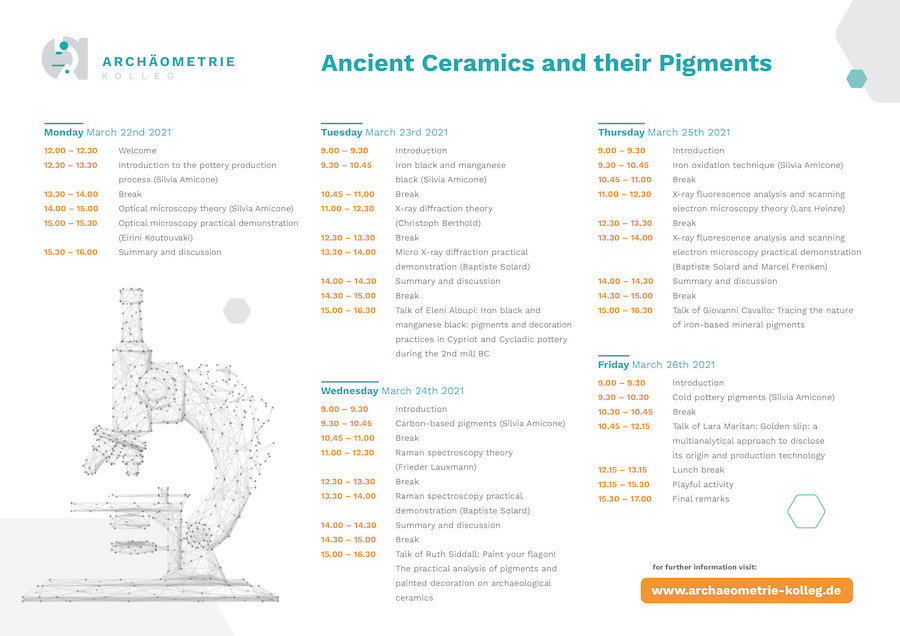attempto online Forschung
29.04.2021
Ancient Ceramics and their Pigments Workshop - March 2021, Tübingen
It is with great enthusiasm that we share our experiences as participants in the workshop Ancient Ceramics and their Pigments. The workshop’s aim was to introduce attendees to current topics in the study of pigments and how they were produced and used in the past. More recently, archaeometric techniques used to analyze pigments on pots have provided innumerous opportunities for further research into systems of trade and production of ancient ceramics. Many of the methodologies discussed in this workshop have implications in the wider study of ceramics, archaeological science, and beyond.
The week-long workshop was hosted by the Competence Center Archaeometry - Baden-Wuerttemberg (CCA-BW) at the University of Tübingen. This event was organized by Dr. Silvia Amicone in collaboration with the Curt-Engelhorn-Centre Archaeometry (CEZA). The workshop is part of the Archäometrie Kolleg project, which is generously sponsored by the Klaus Tschira Foundation (KTS).
The layout of the workshop was well organized, and the online format provided the opportunity for many people all over the world to connect and discuss how the topics in this class can be applied to future study.
Micro-archaeology to characterize pigments
To begin to understand how ceramics are studied, Dr. Silvia Amicone introduced us to the vast world of ceramic production, as experimental archaeology is key in unifying archaeological materials to physical and chemical analyses such as scanning electron microscopy (SEM), X-ray diffraction (XRD), Raman spectroscopy, among other analytical techniques. Additionally, the importance of optical microscopy to providing context for such analyses was highlighted on the first day of the course. Following these talks, MSc student Eirini Koutouvaki demonstrated how this technique can be applied using a video microscope and a polarizing microscope.
Black pigments and their analysis
On day two of the workshop, we were introduced to black pigments. Between the conversation of X-ray diffraction theory by Dr. Christoph Berthold and practical demonstrations of how XRD analysis is carried out in the lab by MSc student Baptiste Solard, we feel we gained much insight into the “best practices” for using XRD in the analysis of pigments. This was concluded by a lecture and discussion by Dr. Eleni Aloupi-Siotis.
On day three we continued the conversation of black pigments and spent the day learning about Raman spectroscopy with PhD candidate, Frieder Lauxmann. We learned how Raman can be an additional resource to extract technological information out of ancient pigments and were given a practical demonstration by MSc student Baptiste Solard. It is important to remember that many archaeometric techniques exist to study ancient pigments, and we feel it was a benefit to all students in the workshop to discuss the pros and cons of each analytical technique, as access to instrumentation and elements being studied are practical considerations that may limit the use of certain analyses. The lecture and discussion led by Dr. Ruth Siddall demonstrated her years of experience in collecting reference samples and applying them to the archaeological record. Understanding what humans were using to paint their pots, walls, and floors, which reveal aspects of technology, use, and function of the material, is of great use to both of us, although we study in different fields within archaeological sciences.
Red pigments and their analysis
On Thursday, we were given the opportunity to learn about two more analytical techniques, X-ray fluorescence (XRF) and Scanning Electron Microscopy (SEM), which was led by Dr. Lars Heinze, followed by a talk on iron oxidation techniques given by Dr. Silvia Amicone and MSc students Baptiste Solard and Marcel Frenken gave a practical demonstration on how these instruments are used, and ample time was provided for the participants to discuss the caveats of using portable XRF and calibration sets and SEM in archaeological science. The day was beautifully tied together by a lecture and discussion led by Dr. Giovanni Cavallo, who studies raw material sources of iron-based mineral pigments, or ochre.
Cold pottery pigments
On the final day of the workshop, Dr. Silvia Amicone introduced the participants to cold pigments and Professor Lara Maritan gave a very interesting talk on the origin and the technological characteristics of golden slip. As a concluding exercise, the participants were given the chance to take part in a collaborative group activity, which provided us with practical experience in the study of the decoration of an ancient pot by applying the knowledge gained during the workshop.
Concluding Remarks
This online workshop gave attendees the chance to connect with people from all around the globe - Europe, Asia, and America. Among the participants were students of all levels, from bachelor to postdoctoral researchers. During the discussion, we all had the unique opportunity to learn about various projects held abroad and to combine different backgrounds to develop relevant archaeometric research questions. In the final discussion Professor Roland Schwab, the scientific director of the CEZA, and experimental archaeologist, Luca Bedini, highlighted the importance of merging together experimental archaeology and archaeometry in the study of ancient technology. All in all, it seems that the format of this course has given us an example of how online workshops can open opportunities for international cooperation and discussion.
From the classical archaeologist to the hobby-potter, this class provided a baseline for students to move forward in the field of ancient pigments. Many archaeologists are excited to start applying scientific techniques to their research and having had access to each other via this workshop will undoubtedly lead to exciting new collaborations and shared knowledge that can be applied to solving complex archaeological problems. We have no doubt that this class has given a valuable skillset to attendees as they move forward in their research, now having the ability to select the analysis that is appropriate for their materials and the research question at hand.
Aspen Cooper (MSc student in Geoarchaeology) and Eirini Koutouvaki (MSc student in Archaeometry)

